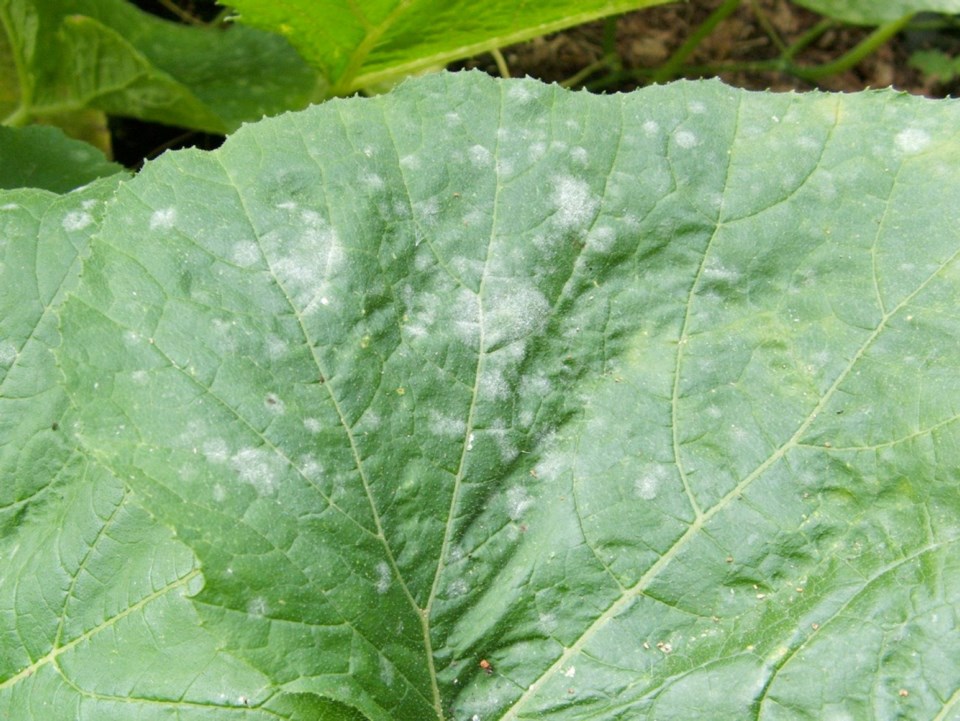Dear Helen: Is there anything I can do to eliminate the mould on my squash plants?S.B.
At this point, at summer’s end, I’d leave the plants to die down naturally. Clean away the spent plants well once the squashes have been harvested.
Powdery mildew is inevitable in late summer, as nights begin to cool and overnight dews bring an increase in humidity. At that time, too, there are many older, susceptible leaves on the plants.
Next year, monitor the plants carefully to catch the first hint of powdery white or grey spots on the leaves, and try these measures.
Spray the leaves a few times each week, around mid-day, with water, which will help to wash disease spores off the leaves.
A spray of one part milk to nine parts water can inhibit powdery mildew spore germination on cucumber and squash leaves. Spray weekly.
A biological control (Bacillus subtilis) is effective in keeping powdery mildew at bay. It used to be sold as Serenade but has been re-named Natria.
Dear Helen: This summer, some of my sunflower plants developed glued-together, Siamese twin type stem arrangements. How unusual is this?
A.N.
It’s not highly unusual. What you describe occurs occasionally in some daisy-like flowers such as gerberas and sunflowers. The condition, called fasciation, causes two or more stems to fuse together, the effect being of one abnormally wide stem carrying joined flowers. Fasciation is most common in certain plants and appears to be fostered by conditions that favour rapid growth, such as a very rich soil or very warm weather. A perennial displaying fasciation one year can be entirely free from it the following year.
Dear Helen: Why have some of my echinacea plants produced double-decker flowers? This seems an utter oddity to me. I’ve never seen such a thing before.
M.G.
The photo you sent shows a smaller flower head apparently arising from a larger flower beneath it. I’ve seen this also in zonal geraniums (perargonium). The condition is caused by distortions of cell growth that arise most commonly in in-bred and highly hybridized plants. Remove such secondary blooms as soon as they appear.
This sort of distortion appears only occasionally and does not indicate any serious issue.
Dear Helen: A few years ago I dug up three roses about to be bulldozed. One is in the garden, the other two in pots. They are very leafy and look healthy, but they have never bloomed.
L.A.
Roses with plenty of healthy looking green growth and no flowers can indicate an over-abundance of nitrogen (N) in the soil, without balancing amounts of phosphorus (P) and potassium (K). Fertilizer labels indicate levels of each of these major nutrients in three numbers arranged in the N-P-K order. Phosphorus and potassium are especially needed for stimulating bloom production.
Trace elements such as iron and magnesium are also important. Seaweed meal is rich in trace minerals and potassium.
Exposure to sunlight is another necessity for good flowering in roses.
There is another possible explanation for there being no bloom, though it’s a long shot and most likely only if the roses had been long neglected before you retrieved them and also if the plants’ foliage looks different than that of mainstream cultivated rose varieties.
Sometimes, if roses are not regularly monitored, and they are budded plants, that are propagated with a selected, named variety joined onto an understock, the understock will sprout and overtake the plant. Understock plants are chosen for qualities such as hardiness and vigorous growth rather than for flowering.
You can determine whether this has happened by brushing some of the soil away from the base of a plant to find a slight bulge above the roots — the budding site. If growth is emerging from below the bulge, the plant’s top growth will be that of the understock plant and not of the named variety you were expecting.
GARDEN EVENT
View Royal meeting. The View Royal Garden Club meets tonight at 7:30 in Shoreline Community School, 2750 Shoreline Dr. David and Crenagh Elliott will discuss gardens in France and England with an emphasis on roses. A judged mini-show will feature exhibits from members’ gardens, and there will be a sales table with plants and garden items. Visitors and new members are welcome. Information at 250-220-5212.



